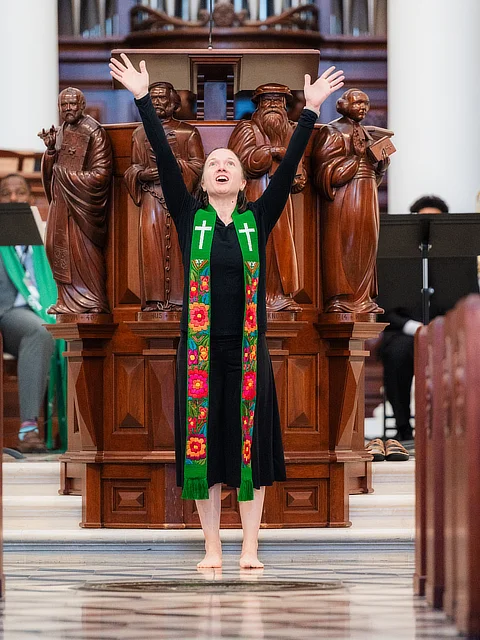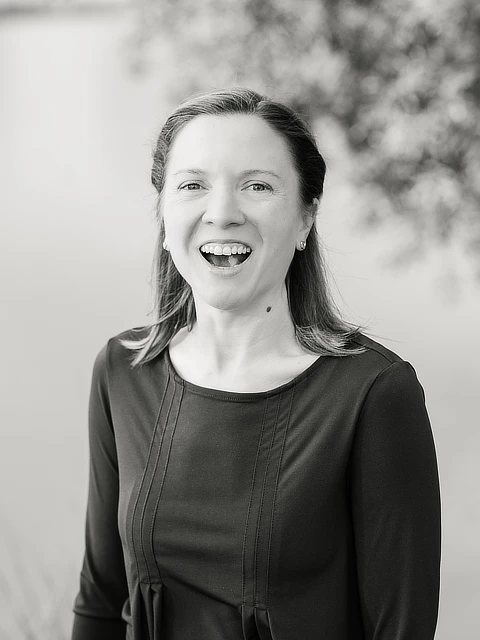
“Bless the Lord, O my soul, and all that is within me, bless his holy name” proclaims the voice of Psalm 103 (NRSV). All that is within me. How can “All that is within me” come out? Do I even know what’s in there? All of it?
For as long as I can remember, I have felt at home in both dance and the church. In each, it was the expressiveness that captured me. Dance allows us to reveal inward truths through the outward movement of our bodies, and the church offers us a space to express our worship to God. In my home church, that expressiveness came through song, prayer, and conversation—but rarely through dance. Yet, dance has the power to make those sacred expressions visible. Both dance and the church draw from an endless well of creative expression: the human heart.
The Hebrew Bible identifies the heart as the seat of wisdom and skill. In Exodus, God calls “all who are wise of heart” to help build the tabernacle—the movable house of worship (Ex. 35:10). The work required a range of specialized skills: woodworkers, metalworkers, weavers, tanners, and artisans skilled in making red, blue, and purple dyes. Two artists, Oholiab and Bezalel, were chosen to lead the effort. But where were the dancers? To find them, we have to look earlier in the Exodus story.
Upon crossing through the Sea to freedom, Moses leads the Hebrew people in song, while Miriam leads all the Israelite women in “dances.” Old Testament scholar Anathea Portier-Young explains that the use of the plural suggests that there are established dances, and that Miriam is leading an improvised expression of worship, with known ritual choreography.[1] Perhaps ritual dances were so ingrained in Israelite worship that it did not occur to the biblical writers to include descriptions or instructions for them. We know that some rituals have been lost over time, like the original tunes for chanting the Hebrew Psalms.
Could Miriam’s ministry have inspired the call to dance in Psalm 150: “Praise the Lord with tambourine and dance!” (v.4)? Since there were established instruments for the Psalms, could there also have been established dances, known by the community who prayed them? Maybe some wisdom was so deeply known in the body that it didn’t make sense to write it down. Just as we know when to rely on the Lord’s Prayer or a favorite song, Miriam and the Israelite women bring out what they knew at a critical time. At the moment of freedom from Pharaoh, they worshiped freely through dance, sharing their art with God and their people.
Dancers embody not only their own worship but that of their community. The dance is not necessarily performed by all, but it is for all. Movement deepens our worship and connection to God. If you’ve seen choreographed dancers in worship, what have you felt? Maybe your own body has sensed a bit of what the dance feels like. Perhaps you’ve anticipated some of the dancers’ movements or been surprised by them. Choreography communicates not only for the dancers themselves but for the community. This is why we go to the ballet, attend Step-Sing, or watch dance shows. The creative movement of bodies communicates to us—and sometimes, it communicates for us—unfolding something we’ve known in life and faith. Dance brings out the wisdom of the heart.
To communicate the value of dance, I find it’s best to let it speak for itself—this is where you come in. Have you ever been moved to sway, clap, or tap your feet while worshiping in song? Maybe it happens without your noticing. If you’re singing, “Raise your hands, all you nations,” isn’t it hard not to raise your hands in worship? [2] It’s not just that the words tell us to. Moving to the words and music deepens our communication and connection with God. God created our bodies with all their ability and mystery. This body He created has things to say to our Creator, and our Creator speaks to us through our bodies.
Let’s use another song, “10,000 Reasons.”[3] It starts with the opening of Psalm 103, artistically interpreted: “Bless the Lord, O my soul; O my soul, worship his holy name!” Here is a simple dance-prayer you can add to this verse, using the song’s words or the Psalm’s, or try both! See how you feel moving to music, or to the spoken words of your prayer. It will work either way, as long as you try it. If you don’t try it, it won’t work. You can do this standing or seated. The guidance for your (gentle) movements are beside the song lyrics below:
“Bless the Lord” - - - raise and open your hands
“O, my soul” - - - place both hands over your heart
“O, my soul” - - - cross arms over your chest and hold your shoulders
“Worship his holy name” - - lower your hands and leave them open at your sides while you lift your face slightly upward
Repeat and notice what you feel and learn. You will have different experiences with and without music; voicing the words aloud or meditating in silence; praying in different locations; with different people or alone; keeping eyes open or closing them. Maybe you’ll come up with more variations. Let me know! I hope this small movement prayer helps bring out “All that is within you.”
Join us at Animate 2025 to cultivate your artistic gifts and deepen your understanding of worship in community. Choose an artistic track that inspires you and participate in a variety of toolbox classes, including dance-focused sessions taught by Rev. Sarah Smoot, the author of this post.
 Reverend Sarah Wilcox Smoot is an ordained Elder in the United Methodist Church and is the senior pastor of Church of the Reconciler in Birmingham, Alabama. She holds a Master of Divinity from Duke Divinity School and is currently pursuing a Doctor of Ministry from Wesley Theological Seminary. Sarah is a lifelong dancer and weaves dance into her ministry with the church. She believes liturgical dance is a ministry of giving thanks for the body, as well as offering worship to God. Sarah creates movement prayers that are accessible to all people in order to reconnect the body with the journey of faith. Sarah’s dance influences include ballet, modern, and African styles, and she performs with Sanspointe Dance Company. She is married to Tyler Smoot, and they have two children ages 7 and 4.
Reverend Sarah Wilcox Smoot is an ordained Elder in the United Methodist Church and is the senior pastor of Church of the Reconciler in Birmingham, Alabama. She holds a Master of Divinity from Duke Divinity School and is currently pursuing a Doctor of Ministry from Wesley Theological Seminary. Sarah is a lifelong dancer and weaves dance into her ministry with the church. She believes liturgical dance is a ministry of giving thanks for the body, as well as offering worship to God. Sarah creates movement prayers that are accessible to all people in order to reconnect the body with the journey of faith. Sarah’s dance influences include ballet, modern, and African styles, and she performs with Sanspointe Dance Company. She is married to Tyler Smoot, and they have two children ages 7 and 4.
To learn more about incorporating dance into worship, explore these posts:
Praying New Ways with Old Psalms
Professors, Peers, and Pupils: How Community Shapes Our Gifts for Worship
[1] Portier-Young, Anathea E. "Miriam's Dance as Embodied Prophecy (Exodus 15:20–21)." Journal of Biblical Literature, vol. 143 no. 2, 2024, p. 219-220. Project MUSE, https://muse.jhu.edu/article/936160.
[2] Tomlin, Chris. “Awesome Is the Lord Most High.” See the Morning. Capitol CMG Publishing, 2006
[3] Redman, Matt, “10,000 Reasons (Bless the Lord).” Spirit & Song, Disc M. Capitol CMG Publishing, 2013
